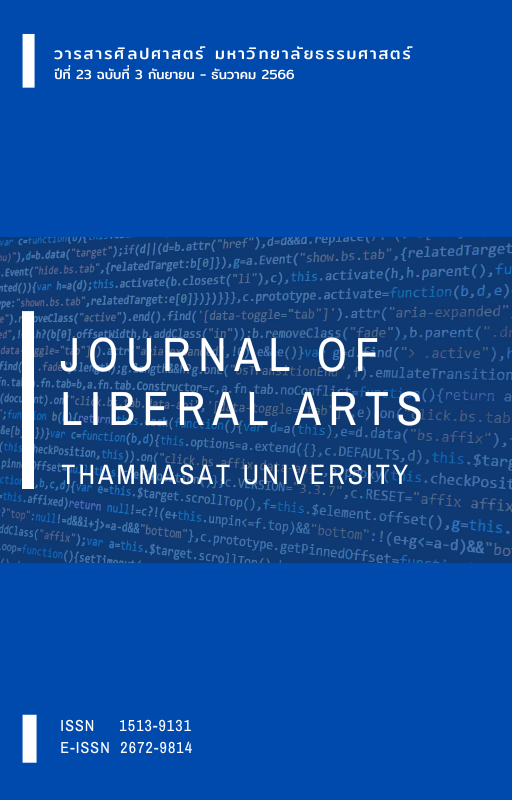ภาษาและอารมณ์ความรู้สึกในสถานการณ์การระบาดโควิด 19 : การศึกษาคลังข้อมูลภาษา
Main Article Content
บทคัดย่อ
บทความนี้ต้องการนำเสนอกระบวนการจัดทำคลังข้อมูลภาษาอารมณ์ความรู้สึกของไทยผ่านโปรแกรม Corpus editor ซึ่งพัฒนาโดยเนคเทค จากข้อมูลเกี่ยวกับสถานการณ์การระบาดของโควิด 19 ระหว่างเดือนมกราคม 2563 ถึงเดือนธันวาคม 2564 รวมจำนวนข้อมูล 3,341,498 คำ และนำคลังข้อมูลที่ได้มาวิเคราะห์อารมณ์ความรู้สึก 7 อารมณ์พื้นฐาน เพื่อพิจารณาว่าอารมณ์ความรู้สึกจากสถานการณ์การระบาดของโควิด 19 ในไทยเป็นอย่างไร ผลการศึกษาเชิงสถิติพบว่าอารมณ์ความรู้สึก Anger พบมากที่สุด และอารมณ์ความรู้สึก Surprise พบน้อยที่สุด ที่น่าสังเกตคืออารมณ์ความรู้สึก Neutral พบอัตราสูงในข้อมูลคลิป ศบค. เท่านั้น ซึ่งดูเหมือนว่าหน่วยงานกลางของรัฐแสดงความชอบธรรมในการสื่อสารกับสาธารณะเพื่อสร้างสมดุลด้านอารมณ์ความรู้สึกของไทย
Downloads
Article Details

อนุญาตภายใต้เงื่อนไข Creative Commons Attribution-NonCommercial-NoDerivatives 4.0 International License.
เอกสารอ้างอิง
จันทิมา อังคพณิชกิจ, สุธาสินี ปิยพสุนทรา, อนุชิต ตู้มณีจินดา, อำนาจ ปักษาสุข, พรทิพย์ เฉิดฉินนภา, และ โกสินทร์ ปัญญาอธิสิน. (2566). ภาษา อารมณ์ความรู้สึก และการสื่อสารสุขภาพของไทยในสถานการณ์การระบาด COVID-19. รายงานวิจัยได้รับทุนสนับสนุนจากกองทุนส่งเสริมวิทยาศาสตร์ วิจัยและนวัตกรรม โดยหน่วยบริหารและจัดการทุนด้านการพัฒนากำลังคน และทุนด้านการพัฒนาสถาบันอุดมศึกษา การวิจัยและการสร้างนวัตกรรม สัญญาเลขที่ B17F640195.
ทัศนีย์ เมฆถาวรวัฒนา. (2553). ความสัมพันธ์ระหว่างภาษา ปริชาน และวัฒนธรรม. วารสารศิลปศาสตร์, 2(2), 151-171.
นววรรณ พันธุเมธา. (2564). คลังคำ. สำนักพิมพ์เครืออมรินทร์.
อมรา ประสิทธิ์รัฐสินธุ์. (2533). ลักษณะสำคัญบางประการในวัฒนธรรมไทยที่แสดงโดยคำเรียกญาติ. ภาษาและวรรณคดีไทย, 7(1), 55-68.
Angkapanichkit, J., Thatsanee, C., Tanyakul, C., & Waranaruechit, S. (2022). An exploration of semantic features for categorizing emotion verbal corpus in Thai. In Thai-Nichi Institute of Technology, 2022 7th International Conference on Business and Industrial Research (ICBIR) (pp. 711-716). http://doi.org/10.1109/ICBIR54589.2022.9786502
Aroonmanakun, W. (2007). Creating the Thai national corpus. MANUSYA: Journal of Humanities, 10(3), 4-17.
Baker, P. (2010). Corpus methods in linguistics. In L. Litosseliti (Ed.), Research methods in linguistics. Continuum.
Baker, P. (2010). Sociolinguistics and corpus linguistics. Edinburgh University Press.
Ekman, P. (1992). An argument for basic emotions. Cognition and Emotion, 6, 169-200.
Ekman, P. (1993). Facial Expression of Emotion. American Psychologist, 48, 384-392.
Expert System & Sociometrica. (2020). Covid-19: Insight and feelings, April 22, 2020: Sadness replaces fear in emotions related to Covid-19. https://www.expert.ai/wp-content/uploads/2020/04/20200422-COVID-19-Insights-Feelings-ENG.pdf
Goddard, C., & Wierzbicka, A. (2014). Words and meanings: Lexical semantics across domains, languages and cultures. Oxford University Press.
Metzler, H., Rimé, B., Pellert, M., Niederkrotenthaler, T., Natale, A. D., & Garcia, D. (2023). Collective emotions during the COVID-19 Outbreak. Emotion, 23(3), 844-858. https://doi.org/10.1037/emo0001111
Renstrom, E. A., & Back, H. (2021). Emotions during the Covid-19 pandemic: Fear, anxiety, and anger as mediators between threats and policy support and political actions. Journal of Applied Social Psychology, 51(8), 861-877.
Semino, E. (2021). “Not soldiers but fire-fighters”–metaphors and COVID-19. Health Communication, 36(1), 50-58.
Schelhorn, I., Schlüter, S., Paintner, K., Shiban, Y., Lugo, R., Meyer, M., & Sütterlin, S. (2022). Emotions and emotion up-regulation during the COVID-19 pandemic in Germany. PlosOne, (7), 2022 https://doi.org/10.1371/journal.pone.0262283
Sutrave, K., Godasu, R., & Liu, J. (2021). Understanding the public sentiment and discourse on COVID-19 vaccine. In The 27th annual Americas Conference on Information Systems (AMCIS) (pp. 1-9). https://aisel.aisnet.org/amcis2021/art_intel_sem_tech_intelligent_systems/art_intel_sem_tech_intelligent_systems/24
Wicke, P., & Bolognesi, M. M. (2020). Framing COVID-19: How we conceptualize and discuss the pandemic on Twitter. PLoS ONE, 15(9), e0240010.
Wilson, A. S, Prescott, J., & Krasniewicz, J. (2016). Using technology for evaluation and support of patients’ emotional states in healthcare. In S. Y. Tettegah & Y. E. Garcia (Eds.), Emotions, Technology, and Health (pp. 3-21). Elsevier.
Wodak, R. (2021). Crisis communication and crisis management during COVID-19. Global Discourse, 11(3), 329–353.


